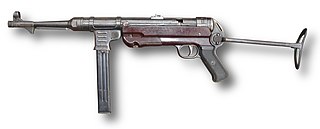
The MP 40 is a submachine gun chambered for the 9×19mm Parabellum cartridge. It was developed in Nazi Germany and used extensively by the Axis powers during World War II.

The StG 44 is a German assault rifle developed during World War II by Hugo Schmeisser. It is also known by its early designations as the MP 43 and MP 44. The StG 44 was an improvement of an earlier design, the Maschinenkarabiner 42(H).

JSC Kalashnikov Concern, known until 2013 as the Izhevsk Machine-Building Plant, is a Russian defense manufacturing concern and joint-stock company headquartered in the city of Izhevsk in the Republic of Udmurtia as well as the capital city of Moscow. The concern designs and produces a wide range of civilian and military weapons including assault rifles, sniper rifles, designated marksman rifles, machine guns, squad automatic weapons, hunting rifles, shotguns, guided artillery projectiles, and a wide range of other precision weapons including remote controlled weapon stations, unmanned vehicles and military robots.

The MAT-49 is a submachine gun which was developed by French arms factory Manufacture Nationale d'Armes de Tulle (MAT) for use by the French Army and was first produced in 1949.

The MP 18 is a German submachine gun designed and manufactured by Bergmann Waffenfabrik. Introduced into service in 1918 by the German Army during World War I, the MP 18 was intended for use by the Sturmtruppen, assault groups specialized in trench combat, as a short-range offensive weapon that would provide individual soldiers with increased firepower over a pistol.
Hugo Schmeisser was a German developer of 20th century infantry weapons.

The Danuvia 39M/43M was a Hungarian submachine gun designed by Pál Király in the late 1930s and used during World War II.

Fegyver- és Gépgyártó Részvénytársaság, known as FÉG, is a Hungarian industrial conglomerate founded on 24 February 1891 in Csepel. The company came under the ownership of MPF Industry Group in 2010. It was an important arms manufacturing company before World War II. Since the acquisition, FÉG is one of the biggest exporters of HVAC products to the international markets in the East-Central European heating device industry.

The SG-43 Goryunov was a Soviet medium machine gun that was introduced during the Second World War. It was chambered for the 7.62×54mmR cartridge, and was introduced in 1943 as a replacement for the older M1910 Maxim machine guns. It was mounted on wheeled mounts, tripods and armored vehicles.

The Pistola Mitragliatrice Fiat Mod. 1915, commonly nicknamed the Villar Perosa, was an Italian portable automatic weapon developed during World War I by the Officine di Villar Perosa.

Small arms and light weapons (SALW) refers in arms control protocols to two main classes of man-portable weapons.

The Frommer Stop is a Hungarian long-recoil, rotating bolt pistol manufactured by Fémáru, Fegyver és Gépgyár (FÉG) in Budapest. It was designed by Rudolf Frommer, and its original design was adopted as the Pisztoly 12M in 1912, created for the Royal Hungarian Army. The handgun was manufactured in various forms from 1912 to 1945 and used in the Hungarian Armed Forces as well as, during the First World War, by the Ottoman Army in limited quantities. The Stop is 165 millimeters (6.5 in) long with a 95 millimeters (3.7 in) 4-groove rifled barrel. Unloaded weight is 610 g (22 oz), and the detachable box magazine holds seven rounds.
The Kucher K1, also known as the Danuvia M53 K1, was a Hungarian magazine-fed submachine gun designed by József Kucher in 1951 for use by paramilitary, paratrooper and police units, based on the Danuvia 44.M prototype submachine gun. It was produced by the titular Danuvia company. The submachine gun was known in Hungarian service as the Gepisztoly 53 Minta or as the "Spigon submachine gun".
Pál Király (1880–1965) was a Hungarian engineer and weapons designer.

An assault rifle is a select fire rifle that uses an intermediate-rifle cartridge and a detachable magazine. Assault rifles were first put into mass production and accepted into widespread service during World War II. The first assault rifle to see major usage was the German StG 44, a development of the earlier Mkb 42. While immediately after World War II, NATO countries were equipped with battle rifles, the development of the M16 rifle during the Vietnam War prompted the adoption of assault rifles by the rest of NATO. By the end of the 20th century, assault rifles had become the standard weapon in most of the world's armies, replacing full-powered rifles and submachine guns in most roles. The two most successful modern assault rifles are the AK-47 and the M16 designs and their derivatives.

The PPS is a family of Soviet submachine guns chambered in 7.62×25mm Tokarev, developed by Alexei Sudayev as a low-cost personal defense weapon for reconnaissance units, vehicle crews and support service personnel.
Ferenc Gebauer was an Austrian-born Hungarian firearms designer and pilot during the First World War.













